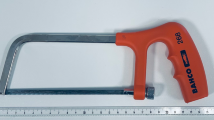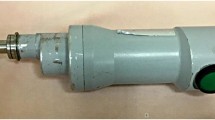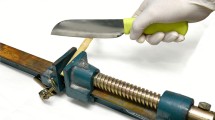Abstract
Cases of criminal dismemberment are encountered in forensic pathology and forensic anthropology. Saw mark analysis aims to determine the type of saw that was used: hand saw versus electrical saw, crosscut and universal saw versus rip saw, size of the teeth (“teeth per inch” TPI), and set type. The goal of this study was to analyze using a stereomicroscope a series of 60 experimental false starts (30 lesions for each saw) produced on human bones by two different handsaws with a high TPI (15 and 32). The lesions caused by these high TPI saws have rarely been described in the forensic literature. Saw 2 (rip hacksaw with a 32 TPI and a wavy set) displayed classical features. In contrast, saw 1 (universal panel saw, TPI 15, alternating set) did not produce the expected characteristics: the minimum width of the kerf was weak, the kerf walls were straight, the striae were straight, and the kerf profile was very peculiar with a succession of peaks and dips that has not yet been described.



Similar content being viewed by others
References
Quatrehomme G (2007) A strange case of dismemberment. In: Brickley MB, Ferllini RR (eds) European cases in forensic anthropology. Charles C Thomas, Springfield III, pp 99–119
Adams BJ, Rainwater CW, Yim AD, Alesbury HS (2019) A retrospective study of intentional body dismemberment in New York City: 1996–2017. J Forensic Sci 64(4):1012–1016
Delabarde T, Ludes B (2010) Missing in Amazonian jungle: a case report of skeletal evidence for dismemberment. J Forensic Sci 55(4):1105–1110
Quatrehomme G (2015) Anthropologie lésionnelle : Dépeçages et démembrements. In: Traité d’Anthropologie médico-légale. De Boeck, Paris, pp 1572–1596
Bilge Y, Kedici PS, Alakoç YD, Ulküer KU, Ilkyaz YY (2003) The identification of a dismembered human body: a multidisciplinary approach. Forensic Sci Int 137(2–3):141–146
Di Nunno N, Costantinides F, Vacca M, Di Nunno C (2006) Dismemberment: a review of the literature and description of 3 cases. Am J Forensic Med Pathol 27(4):307–312
Porta D, Amadasi A, Cappella A, Mazzarelli D, Magli F, Gibelli D, Rizzi A, Picozzi M, Gentilomo A, Cattaneo C (2016) Dismemberment and disarticulation: a forensic anthropological approach. J Forensic Legal Med 38:50–57
Baier W, Norman DG, Warnett JM, Payne M, Harrison NP, Hunt NCA, Burnett BA, Williams MA (2017) Novel application of three-dimensional technologies in a case of dismemberment. Forensic Sci Int 270:139–145
Symes SA, L’Abbe EN, Chapman EN, Wolff I, Dirkmaat DC (2012) Interpreting traumatic injury to bone in medicolegal investigations. In: Dirkmaat DC (ed) A companion to forensic anthropology. Wiley-Blackwell, Chichester, pp 340–389
Symes SA, Berryman HE, Smith OC, (1998) Saw marks in bone: introduction and examination of residual kerf contour. In: KJ Reichs (ed) Forensic Osteology. Advances in the identification of human remains, 2nd edn. Charles C Thomas, Springfield III, pp 389-409
Reichs KJ (1998) Postmortem dismemberment: recovery, analysis and interpretation. In: Forensic osteology, advances in the identification of human remains. Charles C Thomas, Springfield III, pp 353–98
Ross AH, Radisch D (2019) Toolmark identification on bone: best practice. In: Ross AH, Cunha E (eds) Dismemberments: perspectives in forensic anthropology and legal medicine. Academic Press, pp 165-182
Black S, Rutty G, Hainsworth S, Thomson G (2017) Criminal dismemberment : forensic and investigative analysis. CRC Press, Boca Raton
Nogueira L, Quatrehomme G, Rallon C, Adalian P, Alunni V (2016) Saw marks in bones: a study of 170 experimental false start lesions. Forensic Sci Int 268:123–130
Nogueira L, Alunni V, Bernardi C, Quatrehomme G (2018) Saw marks in bones: a study of “secondary features” of false start lesions. Forensic Sci Int 290:157–161
Saville PA, Hainsworth SV, Rutty GN (2007) Cutting crime: the analysis of the “uniqueness” of saw marks on bone. Int J Legal Med 121(5):349–357
Symes SA (1992) Morphology of saw marks in human bone: identification of class characteristics. Dissertation, University of Tennessee, Knoxville
Bonte W (1975) Tool marks in bones and cartilage. J Forensic Sci 20(2):315–325
Andahl RO (1978) The examination of saw marks. J Forensic Sci Soc 18(1–2):31–46
Guilbeau MG (1989) The analysis of saw marks in bone. Dissertation, University of Tennessee, Knoxville
Bernardi C, Nogueira L, Alunni V, Quatrehomme G (2019) Analysis of false start bone lesions produced by an electrical oscillating autopsy saw. Int J Legal Med. https://doi.org/10.1007/s00414-019-02008-1
Pelletti G, Viel G, Fais P, Viero A, Visentin S, Miotto D, Montisci M, Cecchetto G, Giraudo C (2017) Micro-computed tomography of false starts produced on bone by different hand-saws. Legal Med 26:1–5
Love JC (2019) Sharp force trauma analysis in bone and cartilage: a literature review. Forensic Sci Int 299:119–127
Robbins SC, Fairgrieve SI, Oost TS (2015) Interpreting the effects of burning on pre-incineration saw marks in bone. J Forensic Sci 60(Suppl 1):S182–S187
Freas LE (2010) Assessment of wear-related features of the kerf wall from saw marks in bone. J Forensic Sci 55(6):1561–1569
Marciniak SM (2009) A preliminary assessment of the identification of saw maks on burned bone. Forensic Sci 54(4):779–785
Capuani C, Guilbeau-Frugier C, Delisle MB, Rougé D, Telmon N (2014) Epifluorescence analysis of hacksaw marks in bone: highlighting unique individual characteristics. Forensic Sci Int 241:195–202
Bailey JA, Wang Y, van de Goot FRW, Gerretsen RRR (2011) Statistical analysis of kerf mark measurements in bone. Forensic Sci Med Pathol 7(1):53–62
Norman DG, Baier W, Watson DG, Burnett B, Painter M, Williams MA (2018) Micro-CT for saw mark analysis on human bone. Forensic Sci Int 293:91–100
Berger JM, Polkines JT, Moore TL (2018) Analysis of class characteristics of reciprocating saws. J Forensic Sci 63(6):1661–1672
Acknowledgments
We thank very much Marie-Catherine Francino for English editing and for her relevant advice.
Author information
Authors and Affiliations
Corresponding author
Additional information
Publisher’s note
Springer Nature remains neutral with regard to jurisdictional claims in published maps and institutional affiliations.
Highlights
- A stereomicroscopic study of false start lesions in human bones caused by two different handsaws with a high TPI (15 and 32).
- The rip hacksaw with a 32 TPI and a wavy set displayed classical features.
- The universal panel saw, TPI 15, and an alternating set did not show expected features.
- The kerf profile was very peculiar with a succession of peaks and dips that was not described before.
Rights and permissions
About this article
Cite this article
Bernardi, C., Nogueira, L., Cabusat-Mailliet, C. et al. Analysis of false starts lesions on human bones produced by two hand saws with high TPI. Int J Legal Med 134, 613–618 (2020). https://doi.org/10.1007/s00414-020-02251-x
Received:
Accepted:
Published:
Issue Date:
DOI: https://doi.org/10.1007/s00414-020-02251-x




